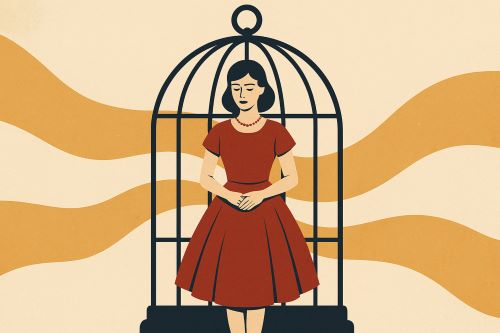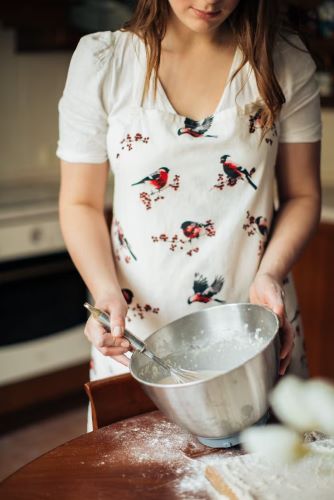

Behind the soft lighting and vintage dresses lies a regressive ideology that threatens gender equality, personal freedom, and historical truth.

By Matthew A. McIntosh
Public Historian
Brewminate
Introduction
A new aesthetic is sweeping across social media — one filled with delicate florals, home-baked sourdough, obedient smiles, and homes where men lead and women serve. Known as the “tradwife” (traditional wife) movement, this trend idealizes a return to rigid gender roles, glorifying domestic submission and patriarchal hierarchy as the path to fulfillment and order.
At first glance, it might appear harmless — even charming. A woman who chooses to be a full-time homemaker, tends to the home, and raises children with intention is making a perfectly valid personal decision. But the tradwife movement is not just about homemaking. It is a coded cultural revival, steeped in nostalgia for an era when women were legally and socially subordinate to men — and it carries dangerous implications for women’s autonomy, queer rights, and democratic equality.
The tradwife is not a lifestyle. It is an ideology. And behind its lace curtains lies a velvet cage.
What Is the Tradwife Movement?
The term “tradwife” combines “traditional” and “wife,” and refers to women who not only embrace homemaking but do so in opposition to feminism. A true tradwife, in this rhetoric, believes a woman’s place is in the home, under her husband’s authority, fulfilling domestic roles while eschewing modern values like career ambition, sexual freedom, and gender equality.
While some participants frame this as a “personal choice,” many popular figures in the movement promote explicitly anti-feminist, anti-LGBTQ+, and nationalist views. They see feminism as having “destroyed the family” and frame their submission as a noble sacrifice to restore “natural order.”
The False Promise of “Choice”
One of the most insidious aspects of the tradwife movement is how it weaponizes the language of freedom and personal choice to advocate for gender roles that historically denied women choice altogether.
“Feminists just want to tell us how to live,” tradwives often argue. “We’re choosing this life freely.”
But that framing ignores the context of historical oppression. For most of human history, women were not allowed to choose anything — not their work, their sexuality, their education, or even whether to marry or have children. The traditional roles being exalted were built under legal systems that denied women the right to vote, own property, or escape abusive marriages.
A woman choosing to opt into homemaking in 2025 is not the same as romanticizing an era where such a life was the only one permitted. The movement, by presenting 1950s-style domesticity as idyllic, erases the violence, exclusion, and systemic coercion that shaped women’s lives for centuries.
Cultural Nostalgia as Political Regression

The tradwife movement isn’t just personal — it’s political. Its popularity is closely tied to a rise in right-wing populism, white nationalism, and Christian fundamentalism. In these circles, the tradwife is promoted as a cure for society’s ills: declining birthrates, feminist “chaos,” queer visibility, and racial diversity.
It’s no coincidence that many tradwife influencers quote fascist slogans like “return to tradition,” glorify 1950s America while ignoring Jim Crow, and associate feminism with moral collapse. The appeal of the tradwife is often less about domestic peace and more about cultural control — a reassertion of patriarchal, heteronormative order in response to the perceived disorder of modern pluralism.
Tradwifery may wear pearls, but its roots are reactionary. It is part of a global backlash against feminism, progressivism, and diversity — and it is gaining ground.
The Mental Health Toll of Idealized Submissiveness
The tradwife fantasy portrays domestic submission as blissful — a way to escape the stress of modern life. But in reality, suppressing one’s autonomy, desires, and individuality can lead to severe psychological distress.
Research consistently shows that rigid gender roles are correlated with:
- Higher rates of depression and anxiety in women
- Greater risk of domestic violence (especially in households with unequal power dynamics)
- Increased financial dependency and isolation
- Loss of self-worth and identity over time
Tradwife rhetoric glamorizes a life where women are financially dependent, socially isolated, and expected to perform emotional and physical labor without recognition or reciprocity. And when it goes wrong — when abuse happens, when needs are unmet — the ideology often blames the woman for failing to submit “enough.”
Exclusion and Erasure of Queer People and People of Color
The tradwife movement is also deeply exclusionary. Its ideal is rooted in white, cisgender, heterosexual, Christian domesticity. Black and brown women, queer couples, trans individuals, and non-Christian families are either erased or framed as threats to the “natural family.”
Tradwife influencers rarely show diverse households or acknowledge that many cultures’ traditional roles include matriarchal leadership, shared domestic labor, or queer kinship structures. Instead, the movement promotes a sanitized, whitewashed version of “tradition” that excludes most of humanity.
And for queer people, the tradwife ethos is explicitly hostile. It reinforces binary gender roles, celebrates compulsory heterosexuality, and often dovetails with anti-LGBTQ+ rhetoric. In the tradwife worldview, there is no room for gender diversity — only obedient women and ruling men.
Weaponizing Femininity Against Feminism

Perhaps most chilling is how the tradwife movement uses femininity as a weapon against women’s liberation. It reframes makeup, fashion, cooking, and submission as superior feminine virtues — and shames women who prioritize careers, independence, or non-domestic goals.
In doing so, it flips feminist victories on their head. What women once fought for — the right to vote, to work, to divorce, to live freely — is repackaged as a threat to femininity itself. Women who reject submission are accused of being “unfeminine,” “man-hating,” or “selfish.”
This rhetoric divides women against each other, reinforces patriarchy, and discredits the very movement that made choices possible in the first place.
The Danger of Soft Power
Unlike overt misogyny, tradwife ideology masquerades as gentle and loving. It speaks in soft tones, posts aesthetic photos, and presents oppression in pastel colors. That’s what makes it so seductive — and so dangerous.
Tradwives aren’t marching with tiki torches — they’re whispering into the ears of millions online, telling them that all their pain will go away if they just stop resisting, give up their voice, and serve their husbands.
But submission is not serenity. It’s surrender.
A Better Way Forward: Choice Without Coercion
Let’s be clear: choosing to be a homemaker, stay-at-home parent, or full-time caregiver is not inherently regressive. The problem is not homemaking — it is the ideological pressure to treat that choice as the only legitimate form of womanhood.
True feminism honors the full range of women’s choices: to parent or not, to work or stay home, to wear pearls or combat boots, to submit or to lead — but always from a place of freedom, not fear.
If we are to push back against the tradwife movement, we must offer a vision of femininity that is inclusive, flexible, and free. One that honors softness and strength, interdependence and independence. One that does not require a return to cages — no matter how beautiful they are made to look.
Conclusion: No Return to the Good Old Days
The so-called “good old days” to which the tradwife movement longs to return were not good for most women — or for people of color, or queer people, or anyone who didn’t fit the mold of suburban obedience.
Behind the curated Instagram feeds and vintage filters is a movement that seeks to roll back progress, suppress complexity, and reimpose roles many fought — and died — to escape.
Let us remember: tradition can be beautiful when chosen freely. But when imposed — through culture, shame, or ideology — it becomes a prison. And no matter how elegantly decorated, a cage is still a cage.
Originally published by Brewminate, 07.10.2025, under the terms of a Creative Commons Attribution-NonCommercial-NoDerivatives 4.0 International license.


